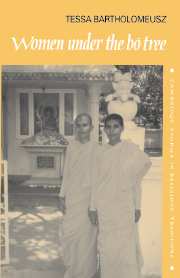Book contents
- Frontmatter
- Contents
- Preface
- Acknowledgments
- Notes on pronunciation
- Dramatis personae
- PART I
- PART II
- 5 The institutionalization of tradition: the early twentieth century and the lay nun
- 6 The lay nun in transitional Ceylon
- 7 The dasa sil mātā in contemporary Sri Lanka
- 8 Novitiates, western lay nuns, and cave dwellers
- 9 The Sri Lankan Bhikkhuī Saňgha: trends and reflections
- Epilogue: Women under the Bō tree
- Appendices
- Notes
- Select bibliographies
- Index and glossary
6 - The lay nun in transitional Ceylon
Published online by Cambridge University Press: 05 November 2011
- Frontmatter
- Contents
- Preface
- Acknowledgments
- Notes on pronunciation
- Dramatis personae
- PART I
- PART II
- 5 The institutionalization of tradition: the early twentieth century and the lay nun
- 6 The lay nun in transitional Ceylon
- 7 The dasa sil mātā in contemporary Sri Lanka
- 8 Novitiates, western lay nuns, and cave dwellers
- 9 The Sri Lankan Bhikkhuī Saňgha: trends and reflections
- Epilogue: Women under the Bō tree
- Appendices
- Notes
- Select bibliographies
- Index and glossary
Summary
INTRODUCTION
Buddhists in the decades prior to independence in 1948 continued to hail lay nuns as exemplars of Buddhist piety, much as they had done since the 1890s. However, we must recognize a bias even in the elaboration of the feminine and its concomitant: widescale interest in female renunciation. As we shall see below, Ceylon Buddhists rallied support for lay nuns primarily for the benefit of the country. Moreover, the laity's strict control over the female renunciants attested to in the sources of the period, suggests a preoccupation with regularizing the lay nunnneries. In this period, the laity continued to experiment with ways to deal with the “social unacceptability (indeed unimaginability) of an autonomous group of women not under the direct regulation and control of some male authority.” The history of the Vihāra Mahā Devī Upāsikārāmaya (VMD) is an example of such experimentation. Despite institutional androcentrism, the sources of the period suggest that the elite perceived that a bhikkhunī saňgha, or something like it, was necessary for the survival of Buddhism in Ceylon.
Just as the destiny of Buddhism was in the hands of the Colombobased, western intelligentsia, so too was the political scenario. The Colombo-based VMD project to re-establish the tradition of female renunciation during the 1930s – organized and fueled by Colombo politicians – reflects this phenomenon. In fact, the very people who determined the course of the politics of the island in the postindependence period sponsored the VMD project.
- Type
- Chapter
- Information
- Women under the Bo TreeBuddhist nuns in Sri Lanka, pp. 109 - 129Publisher: Cambridge University PressPrint publication year: 1994



